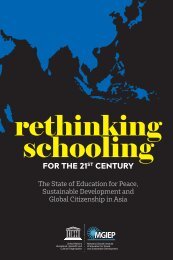Industry Guidelines on Digital Learning: Discussion Draft
The guidelines offered in this document are a first draft to provide a holistic system of characteristics and parameters important for delivering active and engaging learning through digital solutions.
The guidelines offered in this document are a first draft to provide a holistic system of characteristics and parameters important for delivering active and engaging learning through digital solutions.
Create successful ePaper yourself
Turn your PDF publications into a flip-book with our unique Google optimized e-Paper software.
<str<strong>on</strong>g>Guidelines</str<strong>on</strong>g><br />
Purpose<br />
The guidelines are primarily developed to:<br />
• Identify characteristics and parameters important for delivering<br />
and engaging learning through digital soluti<strong>on</strong>s,<br />
• Guide developers of digital learning soluti<strong>on</strong>s to better align their<br />
products with principles and core values of UNESCO MGIEP<br />
and SDG 4.7.<br />
Principles<br />
The following are general principles that describe the scope and nature of these<br />
guidelines:<br />
C<strong>on</strong>tent-agnostic<br />
The purpose of these <str<strong>on</strong>g>Guidelines</str<strong>on</strong>g> is not to supplant educati<strong>on</strong>al instituti<strong>on</strong>s, neither<br />
nati<strong>on</strong>al nor local. Educati<strong>on</strong>al c<strong>on</strong>tent should fit the cultural, social and ec<strong>on</strong>omic<br />
c<strong>on</strong>texts of a territory, and that is the role and the prerogative of the local<br />
educati<strong>on</strong>al instituti<strong>on</strong>s. The choice of the disciplines/branches/subjects/topics<br />
taught in the digital learning applicati<strong>on</strong>s is bey<strong>on</strong>d the scope of these guidelines.<br />
Flexible<br />
In additi<strong>on</strong> to permitting the educati<strong>on</strong>al instituti<strong>on</strong>s to define the c<strong>on</strong>tent that best<br />
suits the situati<strong>on</strong> and needs of their learners, the guidelines are flexible enough to<br />
adapt to the rapidly changing and largely unpredictable societal and ec<strong>on</strong>omic<br />
needs. They will also take into account the specificities of the different age groups:<br />
primary, sec<strong>on</strong>dary, and tertiary educati<strong>on</strong>. Finally, the guidelines are designed to<br />
be flexible enough not to c<strong>on</strong>stitute an obstacle to developers’ creativity or<br />
entrepreneurship.<br />
Evolutive<br />
The guidelines will be further elaborated with the active engagement of a broader<br />
group of specialists and researchers in the different fields of the sciences of<br />
educati<strong>on</strong>: developmental psychology, neuroscience, and educati<strong>on</strong> am<strong>on</strong>g others.<br />
As menti<strong>on</strong>ed previously, this document is likely to evolve over time, in order to<br />
integrate the latest findings of research and field experiments and adapt to the<br />
rapid technical and societal evoluti<strong>on</strong>s.<br />
Holistic<br />
These guidelines encourage embedding socio-emoti<strong>on</strong>al learning al<strong>on</strong>g with<br />
disciplinary knowledge within the design of digital learning applicati<strong>on</strong>s.<br />
FOREWORD | INTRODUCTION | GUIDELINES | CONCLUSION | AUTHORS & REVIEWERS | REFERENCES<br />
PURPOSE | PRINCIPLES | STRUCTURE | MANDATORY GUIDELINES | RECOMMENDED GUIDELINES


















